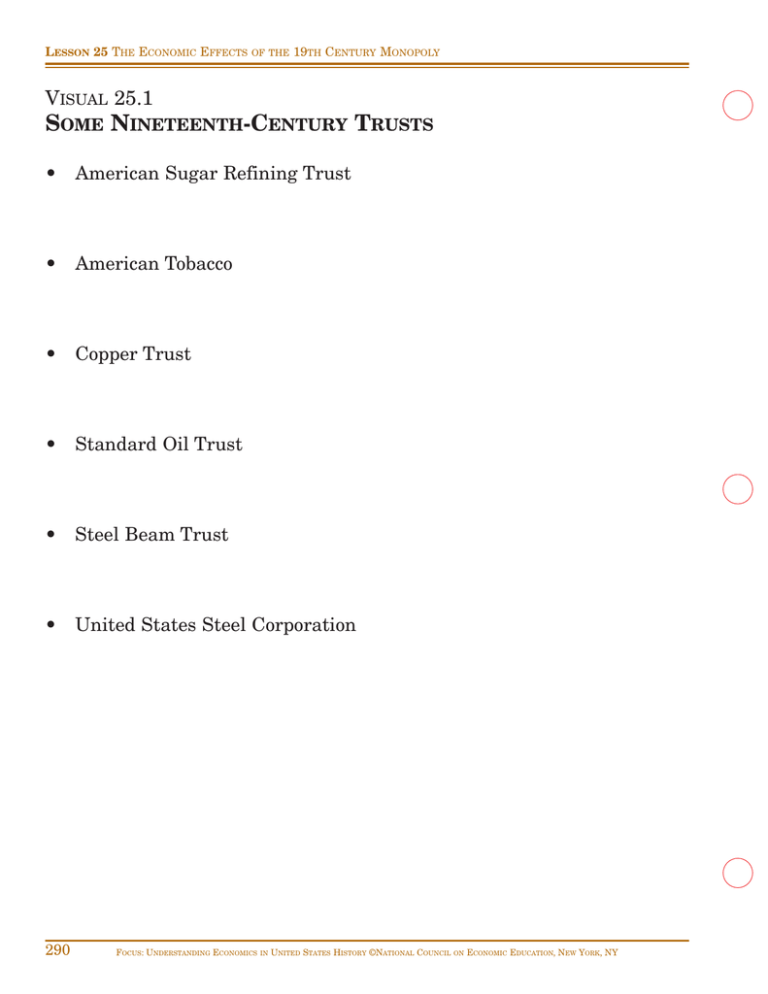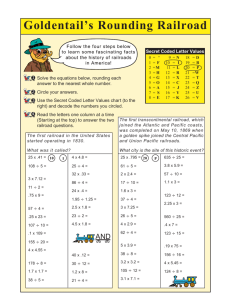S N -C T
advertisement

LESSON 25 THE ECONOMIC EFFECTS OF THE 19TH CENTURY MONOPOLY VISUAL 25.1 SOME NINETEENTH-CENTURY TRUSTS • American Sugar Refining Trust • American Tobacco • Copper Trust • Standard Oil Trust • Steel Beam Trust • United States Steel Corporation 290 FOCUS: UNDERSTANDING ECONOMICS IN UNITED STATES HISTORY ©NATIONAL COUNCIL ON ECONOMIC EDUCATION, NEW YORK, NY THE ECONOMIC EFFECTS OF THE 19TH CENTURY MONOPOLY LESSON 25 VISUAL 25.2 RAILROADS IN THE UNITED STATES, 1860 FOCUS: UNDERSTANDING ECONOMICS IN UNITED STATES HISTORY ©NATIONAL COUNCIL ON ECONOMIC EDUCATION, NEW YORK, NY 291 LESSON 25 THE ECONOMIC EFFECTS OF THE 19TH CENTURY MONOPOLY VISUAL 25.3 BUSINESS ENTITIES Different types of business firms Goal is maximizing profits Pure competitor Cartel FOCUS: UNDERSTANDING ECONOMICS Profit levels The interactions of buyers and sellers in a large market determine the equilibrium price. Zero profits above the competitive return on capital. The pure competitor accepts the market price because competition is so steep and products produced by each firm are identical. Yes The monopolist determines the price, given the demand for the product. The product is unique and there are no competitors. Positive profits. The monopolist dictates price due to being the only supplier of the item in demand. Prices tend to increase because there are no competitive forces at work. Yes Groups of firms produce similar items. Together, they have monopoly power, and there are no close substitutes for the cartel’s products. Positive profits, dependent on the membership upholding the agreement to raise prices and restrict output as in a monopoly. Cartels are illegal in the U.S. Yes Monopolist 292 Price determination IN UNITED STATES HISTORY ©NATIONAL COUNCIL ON ECONOMIC EDUCATION, NEW YORK, NY THE ECONOMIC EFFECTS OF THE 19TH CENTURY MONOPOLY LESSON 25 VISUAL 25.4 HOW EASILY CAN CARTELS OR TRUSTS COLLUDE AND RAISE PRICES? Members of the Railroad Cartel make the following assumptions: • All members of the railroad cartel provide identical services. • There are no costs of production. • The railroad customer must ship 10 items. All, one or any combination of the railroad services can be used without incurring extra costs. The Cartel Agreement: • Members of the railroad cartel can agree to choose one of the four pricing schemes below. • Each member is to write the cartel price on the paper provided. The number written on the paper can be changed at any point prior to the time the transaction between the customer and railroad occurs. Actual Price Per Unit Shipped Total Revenue (P x Q) $4-$4-$4 All firms make $13 revenue (= $4 x 3.33 items shipped + $4 x 3.33 + 4 x 3.33) $3-$3-$3 All firms make $10 in revenue (= $3 x 3.33 items shipped + $3 x 3.33 + 3 x 3.33) $3-$3-$4 Firms pricing at $3 per unit make $15, otherwise $0 revenue (= $3 x 5 items shipped + $3 x 5 + 4 x 0) $3-$4-$4 The one firm pricing at $3 makes $30, otherwise $0 profit (= $3 x 10 items shipped + $4 x 0 + 4 x 0) Adopted from: Tawni Ferrarini and Robert Quinn, “The Oligopoly Game” The Michigan Social Studies Journal (Spring, 2005), pp. 28-34. FOCUS: UNDERSTANDING ECONOMICS IN UNITED STATES HISTORY ©NATIONAL COUNCIL ON ECONOMIC EDUCATION, NEW YORK, NY 293 LESSON 25 THE ECONOMIC EFFECTS OF THE 19TH CENTURY MONOPOLY VISUAL 25.5 HOW COMPETITIVE WERE THE RAILROADS OF THE 1870S? Some railroad engaged in anti-competitive practices such as price fixing. However, it remained difficult to suppress competition even in the railroad industry. • Railroads added tens of thousands of miles of track in the 1870s and 1880s. • Additional track provided opportunities for increased competition. • Short hauls in rural areas faced little direct competition. However, long hauls between cities usually had two or more railroads in competition. • Efforts by railroads to form agreements to fix their rates and find other means to reduce competition almost always failed. • Aggressive managers or owners (such as Jay Gould) would break the agreements and begin price cutting. • Price cutting took a variety of forms such as price discrimination and rebates. The effect to drive down rates, however, was the same. 294 FOCUS: UNDERSTANDING ECONOMICS IN UNITED STATES HISTORY ©NATIONAL COUNCIL ON ECONOMIC EDUCATION, NEW YORK, NY





